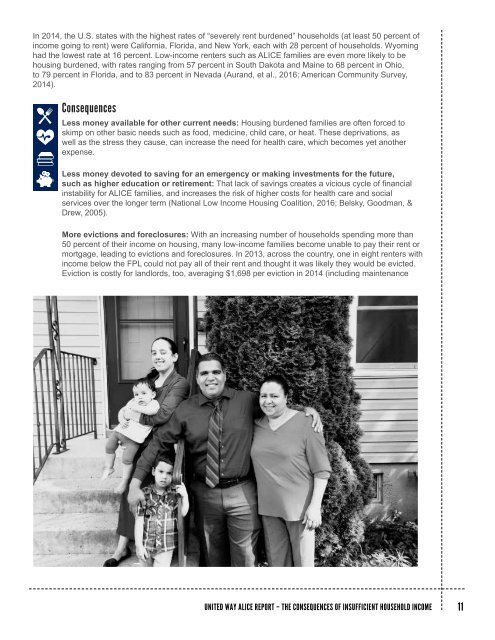The Consequences of Insufficient Household Income
This new Consequences of Insufficient Household Income report provides a deeper level of understanding of the choices that ALICE and poverty-level families across the country make when they do not have enough income or assistance to afford basic necessities, and the consequences of those choices.
This new Consequences of Insufficient Household Income report provides a deeper level of understanding of the choices that ALICE and poverty-level families across the country make when they do not have enough income or assistance to afford basic necessities, and the consequences of those choices.
You also want an ePaper? Increase the reach of your titles
YUMPU automatically turns print PDFs into web optimized ePapers that Google loves.
In 2014, the U.S. states with the highest rates <strong>of</strong> “severely rent burdened” households (at least 50 percent <strong>of</strong><br />
income going to rent) were California, Florida, and New York, each with 28 percent <strong>of</strong> households. Wyoming<br />
had the lowest rate at 16 percent. Low-income renters such as ALICE families are even more likely to be<br />
housing burdened, with rates ranging from 57 percent in South Dakota and Maine to 68 percent in Ohio,<br />
to 79 percent in Florida, and to 83 percent in Nevada (Aurand, et al., 2016; American Community Survey,<br />
2014).<br />
<strong>Consequences</strong><br />
Less money available for other current needs: Housing burdened families are <strong>of</strong>ten forced to<br />
skimp on other basic needs such as food, medicine, child care, or heat. <strong>The</strong>se deprivations, as<br />
well as the stress they cause, can increase the need for health care, which becomes yet another<br />
expense.<br />
Less money devoted to saving for an emergency or making investments for the future,<br />
such as higher education or retirement: That lack <strong>of</strong> savings creates a vicious cycle <strong>of</strong> financial<br />
instability for ALICE families, and increases the risk <strong>of</strong> higher costs for health care and social<br />
services over the longer term (National Low <strong>Income</strong> Housing Coalition, 2016; Belsky, Goodman, &<br />
Drew, 2005).<br />
More evictions and foreclosures: With an increasing number <strong>of</strong> households spending more than<br />
50 percent <strong>of</strong> their income on housing, many low-income families become unable to pay their rent or<br />
mortgage, leading to evictions and foreclosures. In 2013, across the country, one in eight renters with<br />
income below the FPL could not pay all <strong>of</strong> their rent and thought it was likely they would be evicted.<br />
Eviction is costly for landlords, too, averaging $1,698 per eviction in 2014 (including maintenance<br />
UNITED WAY ALICE REPORT – THE CONSEQUENCES OF INSUFFICIENT HOUSEHOLD INCOME<br />
11




